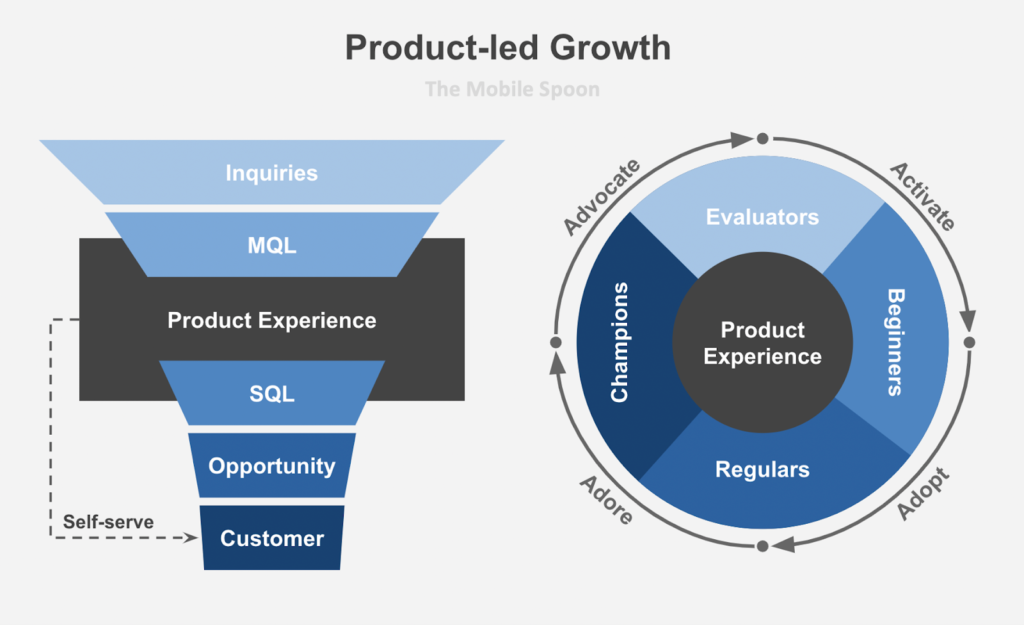From Sales-led to Product-led: A Guide for B2B Enterprise
-
Odun Odubanjo
- 10 min read


photo credit: The Mobile Spoon
In today’s evolving business landscape, an increasing number of B2B enterprise organizations are making the strategic shift from a traditional Sales-led to Product-led approach. This transition aims to align the business with how modern buyers prefer to research, evaluate, and purchase products.
While a sales-led model relies heavily on direct sales interactions to drive revenue, a product-led approach centers on the product itself being the main vehicle for acquiring, converting, and expanding customer relationships.
For many scale-ups, moving from sales-led to product-led holds tremendous potential but also poses meaningful challenges that require careful navigation. In this comprehensive guide, we’ll explore what’s driving the rise of product-led, the tangible benefits this transition can unlock, key steps for integrating product-led approaches into your existing organization, and how to overcome common challenges along the journey.
The Forces Driving Sales-led to Product-led
What market dynamics are causing this pronounced shift? Primarily, it comes down to changing customer preferences and buying behaviors in the digital age.
Specific factors include:
- Increased self-education – With information readily accessible online, buyers are spending more time researching and vetting solutions independently before engaging with sales teams.
- Rise of digital buying – Customers expect seamless online buying and product trials before speaking with a sales rep.
- Subscription models – Recurring SaaS and subscription models center on ongoing value delivery rather than a one-time sale.
- Shortened sales cycles – Buyers look to prove value quickly, increasing reliance on the product itself versus lengthy sales interactions.
These new realities demand that companies engage prospective customers on their terms. A product-led approach directly serves modern buyers through convenient digital buying, generous trials and onboarding, and continuing value delivery.
4 Core Benefits of Transitioning to Product-Led
What tangible upsides can you expect from undertaking this transition? Let’s explore some of the most impactful benefits:
Increased customer autonomy and satisfaction
By giving buyers more control over their journey, product-led models increase customer satisfaction and loyalty. Buyers appreciate convenient access to educate themselves and self-serve on their own timelines.
Accelerated revenue growth
When buyers can easily initiate trials and make purchases online, deal velocity increases significantly. Reduced friction and sales involvement required per deal improves overall conversion rates.
Improved product adoption and retention
Onboarding users directly through generous, self-serve product trials and in-app experiences ensures they experience your product’s core value early on. This drives higher adoption and retention.
Richer customer insights
Product analytics give granular visibility into how customers truly use and engage with your solution. These insights allow you to continuously refine the product experience.
💬 Questions about From Sales-led to Product-led: A Guide for B2B Enterprise?
Our team typically responds within minutes
Integrating Product-Led into Existing Sales-led Organizations
Transitioning to product-led represents a substantial shift for most established companies. Leaders must be intentional about integration into existing systems and processes.
Critical steps include:
- Define roles and responsibilities – Clearly delineate product, engineering, and technical marketing roles that may not have existed previously. Reduce ambiguities between product and sales.
- Break down silos – Foster tight collaboration between product, sales, marketing, customers success and other groups through cross-functional teams, shared KPIs, and aligned processes.
- Standardize systems and data – Clean up disjointed systems by standardizing on unified platforms for product analytics, customer data, and feedback management. Create a “single source of truth.”
- Realign incentives and metrics – Compensation, quotas, bonuses and other performance metrics should tie directly into product-led goals like activations, retention, and expansion.
- Communicate internally – Provide extensive education, top-down messaging, and training to align the entire organization around the product-led mission and strategy.
By proactively managing organizational realignment and change management, you can pave the way for successful execution.
Overcoming Common Challenges and Pitfalls
While the benefits clearly outweigh the costs, avoiding some common stumbling blocks will smooth the path. Some of the most frequent challenges that crop up include:
Siloed data and teams – Sales, marketing, product, and engineering may continue operating in silos rather than collaboratively, undermining integration.
Under-investment in product – Scaling product teams and product-led technologies requires securing ample budget and resources you may lack if product was not a priority before.
Over-reliance on sales – Entrenched cultures or individual sales superstars clinging to status quo can slow adoption of product-led systems.
Feature bloat – In an enthusiasm for product-led, teams may overload products with features versus prioritizing core must-have capabilities.
To circumvent these pitfalls, maintain focus on the end-to-end customer journey as you drive changes. Additionally, highlight quick wins and celebrate product-led successes to secure further buy-in. Patience and persistence are vital.
Key Takeaways and Next Steps
Transitioning established companies from sales-led to product-led takes concerted effort but delivers immense competitive advantage. Keep these recommendations top of mind:
- Educate the organization on product-led benefits and the drivers behind it.
- Foster cross-functional collaboration – break down silos between teams.
- Standardize systems and data sets to support product-led.
- Set product-focused incentives and metrics.
- Plan for substantial investment in product, analytics, and engineering.
- Maintain intense focus on the end-to-end customer journey.
By putting the product and customer value delivery at the core, product-led organizations gain resiliency, agility, and alignment with modern buyer preferences. For scale-ups ready to undertake this transformation, the opportunities far outweigh the challenges.
💬 Questions about From Sales-led to Product-led: A Guide for B2B Enterprise?
Our team typically responds within minutes



